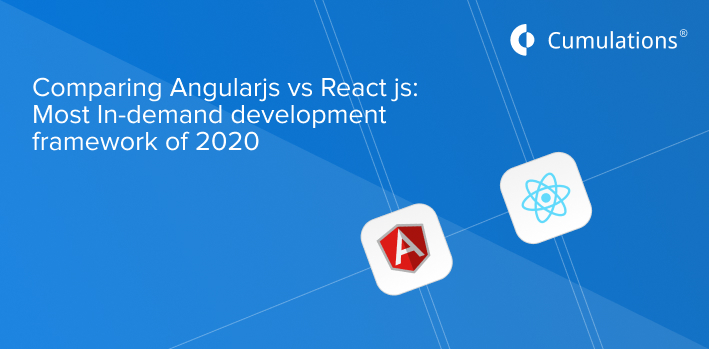
There are a lot of developers who develop mobile applications and projects using Javascript. But if you have to choose the right framework or library for your project, they are still confused.
Angular and ReactJs are top priorities, but most people still don’t know what’s right for their project. A freshman wants to know someone who is in high demand for something easy to learn for everyone.
Comparison between React and Angular
The contrast between React and Angular in 2020 remains a significant subject. The number of JS tools for rapidly developing single-page applications continues to grow, making technical choices difficult for web developers. Since its release in 2009, AngularJS has got included in almost all lists of 10 JavaScript frameworks. This Model-View-Controller framework is prevalent among web developers.
Componentization:
AngularJS
AngularJS is based on three layers (models, views, controllers), which is a typical one-page application, so it has a very complex and fixed structure. For example, if you write your reusable components using your controller and templates, each block of code should be written to a separate file. When explaining the instructions, add a link to the instruction template and combine these parts. The AngularJS directives represent the logic of the application model. I also added a controller that provides the scope or context $ required by the model. The controller is also getting written to another file.
React
Facebook, the author of React, chose a different architecture from MVC frameworks like AngularJS. Extensive JavaScript library for updating React user views. which controls the flow of Facebook applications. Writing an application in a React component is similar to creating a JavaScript program from a function.
React and Angular data binding:
AngularJS
AngularJS uses a bidirectional data link to bind the Document Object Model (DOM) values ​​to model data via a controller. Indeed, this allows you to write less structured code to create interactions between the application components (views and models).
The disadvantage of the angular bidirectional data link method is its impact on performance. Automatically create observations for each AngularJS binding. Observers built into the application that links the element during development can also cause situations.
React
In React, you can direct the data flow in one direction. So where the data changes are always transparent. Note that thanks to ReactLink, you can use the bidirectional data link in React before v15.
To implement the React unidirectional data flow, Facebook has created its application architecture, Flux. You can only submit jobs to the repository after a full update. In our own experience, this can be very useful when using dynamically updated Flux data.
The React unidirectional data flow controls complexity. It is much easier than only using an extensive AngularJS application as well as debugging the components contained in the comprehensive React application itself.
React vs. Angular Performance:
AngularJS
There are two considerations when talking about the performance of Angular. As mentioned above, Angular 1.x and later versions rely on a two-way data link. This concept is getting based on “dirty control,” which is a delay mechanism compared to AngularJS applications.
When you link HTML values ​​using a template, AngularJS observes each link to track changes in the DOM. Once the view is updated (“dirty”), AngularJS executes the $ digest loop by comparing the new value with the initialized (linked) value. Too many observers in this application are behind the significant drop in performance.
If several values ​​(views) are interdependent, this disadvantage is even more painful. AngularJS stops and re-executes the current $ digest loop when it finds that a change in another value has triggered a shift in value.
You can link fields to different perspectives and models. Another disadvantage of the AngularJS framework is its operation with the DOM. It also negatively affects the performance of this app. However, Angular 2 and Angular 2 offer an optional two-way data link.
React
React does not send new HTML to the browser, only changing HTML. This method is more effective than the manner provided by AngularJS. For unidirectional data binding, React does not use observations to track changes in the actual DOM. Overall, React makes it easier to monitor the performance of your application. But that doesn’t mean you can’t create a quick app in AngularJS.
React vs. Angular Resolving Dependencies:
AngularJS
AngularJS writes the dependencies in another file. As a parameter of a task, dependencies are transmitted only in random order. Indeed, vanilla JavaScript differs from AngularJS for the correct order of standard JS parameters.
The AngularJS framework has two functions $ inject and $ provide, which allow the injection of dependencies. You should also mention the problem of dependency injection in AngularJS. Simplify things, and the code reducer shortens dependency names to something like $ b and $ y. The actual names are $ range, $ filter, and are included in the example above. On the positive side, solving this problem is very simple.
React
You can use several tools to insert React application dependencies automatically. This tool includes the EcmaScript 6 module, available in Browserify, RequireJS, Babel, ReactJS-di, etc. The only problem is to choose the tool to use.
Directives and Templates:
AngularJS
AngularJS directives are a way to organize your work/code on the DOM. If you are using AngularJS, you need instructions to access the DOM. The model requires an element whose instruction is getting described as an attribute. Very simple. But if the AngularJS directives are fully defined, they are very complicated. An object with the parameters returned by the directive contains about ten properties. But I don’t know how (and why) the priority terminal scopes and other attributes are defined.
Overall, you use standard directives and specific directives to link DOM elements to AngularJS applications.
React
It does not provide a separation between React models and model commands or logic. The logic of the model must get written in this model itself. You pass an object with this function attribute. Finally, we define the rendering property of the component. It is clear what happens to the model, how to render it, and what information the property provides.
This method of defining models and logic is better because, in the beginning, it takes less time to understand what is going on.
Conclusion
AngularJS and React are great for creating single-page applications. However, the best choice for a particular project depends on how these tools are getting used.
It seems natural to use React to write old JavaScript style and build HTML around it. However, there are many other tools you need to master, including Flux. AngularJS then implements another way of organizing around HTML. Therefore, the syntax for view exceptions and solutions may appear. But as you get used to AngularJS, you can be assured of the benefits of this feature. If you are looking for a ReactJs Development company for your business, Contact Cumulations
1. Top 10 Node js Frameworks for Web & Mobile App Development


 +91-984-5825982 | +91-996-4689921
+91-984-5825982 | +91-996-4689921 sales@cumulations.com
sales@cumulations.com Send your requirement
Send your requirement 



